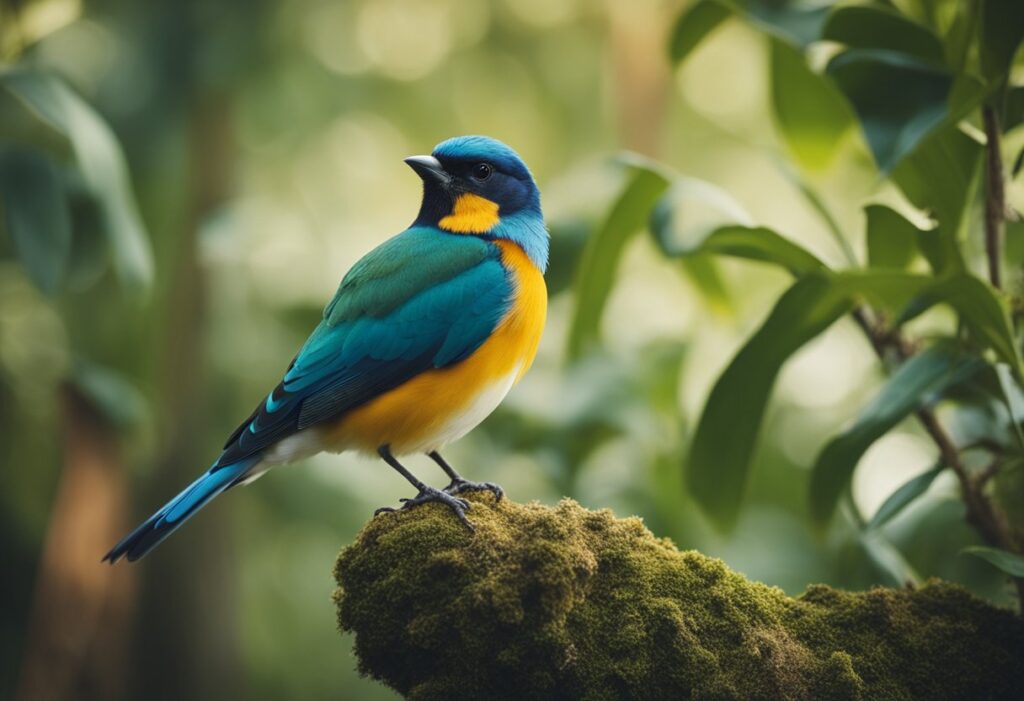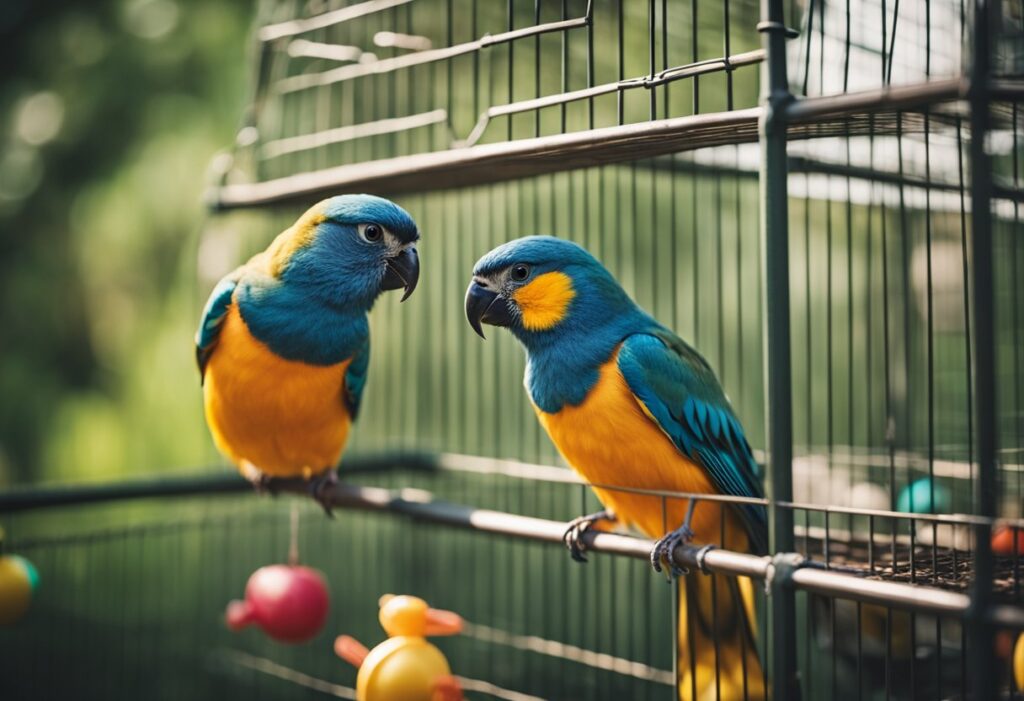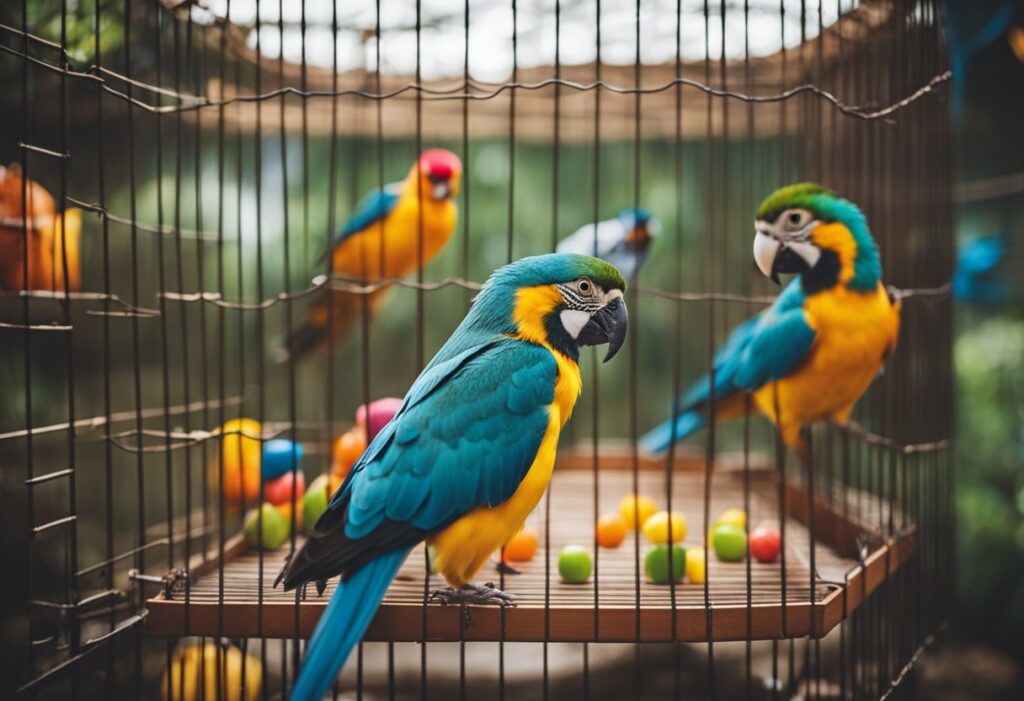Birds need perches to rest, exercise, and play. Perches are essential for birds to maintain their physical and mental health. However, choosing the right perch can be daunting, as there are many types of bird perches available in the market. In this article, we will guide you through the process of choosing the best bird perches for your feathered friends.

When choosing a bird perch, there are several factors to consider, such as the size of your bird, the perch’s material, and the perch’s shape. A perch that is too small or too big can cause discomfort or health problems for your bird. The perch’s material should be non-toxic and easy to clean, and the perch’s shape should allow your bird to grip it comfortably. We will discuss these factors in more detail in the following sections.
Key Takeaways
- Choosing the right bird perch is crucial for your bird’s physical and mental health.
- Consider the size, material, and shape of the perch when choosing the best one for your bird.
- Regular maintenance and safety checks are necessary to ensure your bird’s comfort and safety.
Best Bird Perches
| Product Short Name | Rating | Price |
|---|---|---|
| Pets vv Bird Rope Perch | 4.7 | $9.99 |
| Bird Rope Ring Swing Perch | 4.7 | $9.98 |
| Aigou Bird Spiral Rope Perch | 4.7 | $19.99 |
| Bird Perch Bird Toys Parakeet | 4.6 | $9.99 |
| Bird Rope Perch with Bell | 4.6 | $11.98 |
| ESRISE 8 Pcs Parakeet Cockatiel Toys | 4.6 | $11.99 |
| Niteangel Parrot Cage Perch | 4.6 | $9.99 |
| Bird Parrot Swing Toys | 4.6 | $14.95 |
| JW Pet Insight Sand Perch | 4.6 | $3.66 |
| LIMIO Bird Toys Playground | 4.5 | $28.99 |
| BILLIOTEAM 4 Pack Natural Wood Perch | 4.5 | $13.99 |
| FrgKbTm Bird Perches Platform Swing | 4.4 | $15.99 |
| CZWESTC 8 Pieces Natural Wood Perch | 4.4 | $12.99 |
| 5PCS Bird Perch Stand | 4.4 | $15.99 |
| kathson Natural Parrot Perch | 4.4 | $19.99 |
| LOPERDEVE Bird Mirror with Rope Perch | 4.4 | $9.99 |
| Rypet Parakeet Nesting Box | 4.3 | $14.99 |
| 20Pcs Sand Perch Covers | 4.3 | $9.99 |
| PIAOLGYI Perch for Bird Buddy | 4.2 | $10.99 |
| GIFANK Heated Bird Perch | 4.3 | $23.99 |
Choosing the Right Perch
Choosing the right perch for your bird is crucial to their comfort and health. Here are some factors to consider when selecting the best bird perch.
By Size and Species
Different birds have different needs when it comes to perches. For example, larger birds such as parrots require thicker and sturdier perches to support their weight, while smaller birds such as finches and canaries prefer thinner perches that are easier to grip. It’s important to choose a perch that is suitable for your bird’s size and species to ensure their safety and comfort.
Material Considerations
Bird perches come in a variety of materials, including wood, plastic, and metal. Wood perches are a popular choice because they mimic the natural perches that birds would encounter in the wild. However, plastic and metal perches are also suitable as long as they are non-toxic and easy to clean.
Perch Diameter and Texture
The diameter and texture of the perch are also important considerations. A perch that is too thin can cause discomfort and foot problems, while a perch that is too thick can be difficult for birds to grip. The ideal diameter of a perch should be between 1/2 inch and 1 inch, depending on the size of your bird. Additionally, the texture of the perch should be rough enough to provide grip but not so rough that it causes irritation or injury to your bird’s feet.
When it comes to choosing the best bird perches, it’s important to consider the size and species of your bird, the material of the perch, and the diameter and texture of the perch. By taking these factors into account, you can ensure that your bird has a comfortable and safe place to perch.
Types of Bird Perches
When it comes to selecting the best bird perches for your feathered friends, there are a variety of options to choose from. In this section, we will explore the different types of bird perches available on the market, including natural wood perches, rope perches, heated perches, therapeutic perches, and novelty perches.
Natural Wood Perches
Natural wood perches are a popular choice for many bird owners. They are made from untreated wood and come in a variety of shapes and sizes. Natural wood perches mimic the branches that birds would perch on in the wild, providing a comfortable and familiar surface for them to rest on. These perches also help to keep your bird’s feet healthy by promoting exercise and preventing foot problems. Some popular natural wood bird perches include the A&E Java Wood Multi-Branch Perch and the Prevue Pet Products Naturals Rope Ladder.
Rope Perches
Rope perches are another popular option for bird owners. They are made from soft cotton rope and come in a variety of colors and sizes. Rope perches are comfortable for birds to grip and provide a soft surface for them to rest on. They also promote exercise and help to prevent foot problems. Some popular rope bird perches include the K&H Pet Products Thermo-Perch and the Penn Plax Bird Life Natural Rope Perch.
Heated Perches
Heated perches are a great option for birds that live in colder climates. These perches are designed to keep your bird warm and comfortable during the winter months. They are made with a heating element that warms the perch to a comfortable temperature. Some popular heated bird perches include the K&H Pet Products Thermo-Perch and the K&H Pet Products Snuggle Up Bird Warmer.
Therapeutic Perches
Therapeutic perches are designed to help birds with foot problems or arthritis. These perches are made with a textured surface that helps to massage your bird’s feet and promote circulation. They also provide a comfortable surface for birds to rest on. Some popular therapeutic bird perches include the Polly’s Pastel Perch and the K&H Pet Products Thermo-Perch.
Novelty Perches
Novelty perches are a fun way to add some personality to your bird’s cage. These perches come in a variety of shapes and sizes, including perches shaped like branches, ladders, and even pirate ships. While novelty perches may not provide the same health benefits as other types of bird perches, they can provide entertainment and stimulation for your bird. Some popular novelty bird perches include the Penn Plax Bird Life Pirate Ship Perch and the Prevue Pet Products Naturals Rope Ladder.
In summary, there are many different types of bird perches available on the market, each with its own unique benefits. When selecting a perch for your bird, it is important to consider your bird’s size, species, and individual needs. By providing your bird with a comfortable and stimulating perch, you can help to promote their health and well-being.
Health and Comfort

Ensuring the health and comfort of our feathered friends is essential for their overall well-being. One way to achieve this is by providing them with the right perches. In this section, we’ll discuss the various ways in which perches can promote healthy feet and prevent discomfort.
Preventing Bumblefoot
Bumblefoot is a common condition in birds that can be caused by perches that are too hard or too thin. It occurs when the skin on the bottom of the bird’s foot becomes inflamed and infected. To prevent this, we should choose perches that are of appropriate size and made of materials that are comfortable for the bird to stand on. Manzanita perches, for example, are made from hardwood and provide an irregular surface that promotes foot exercise while preventing the development of bumblefoot.
Ensuring Proper Grip
Birds need a perch that allows them to grip it properly. A perch that is too smooth or too slippery can cause the bird to lose its grip, leading to falls and injuries. To ensure proper grip, we should choose perches that are textured and provide a comfortable grip. One such perch is the Kintor perch, which has a hard coating on the surface that keeps beaks and nails trimmed naturally while providing excellent foot exercise.
The Role of Texture
Perches with a textured surface can help promote healthy feet by providing a surface that is comfortable for the bird to stand on. Textured perches also help prevent the development of bumblefoot by promoting foot exercise and preventing pressure sores. A rope bungee bird perch, for example, provides a coiled design that encourages physical activity and helps birds improve balance, while its pure cotton rope is safe and easy to grip.
In conclusion, choosing the right perch is essential for promoting the health and comfort of our feathered friends. By selecting perches that prevent bumblefoot, ensure proper grip, and have a textured surface, we can help our birds maintain healthy feet and enjoy their perches to the fullest.
Maintenance and Safety

When it comes to keeping our feathered friends healthy, it’s essential to maintain a clean and safe environment for them. This includes their perches, which can harbor bacteria and other harmful substances if not cleaned regularly. In this section, we will cover the best practices for maintaining and ensuring the safety of your bird’s perches.
Cleaning Perches
Cleaning perches is an essential aspect of maintaining a healthy environment for your bird. We recommend cleaning the perches at least once a week. You can use warm, soapy water to clean the perches thoroughly. It’s important to rinse the perches thoroughly and let them dry completely before returning them to your bird’s cage. You can also use a bird-safe disinfectant to clean the perches, but be sure to follow the manufacturer’s instructions carefully.
Regular Inspection
Regular inspection of your bird’s perches is crucial for their safety. Check the perches for any signs of wear and tear, such as splinters or cracks. If you notice any damage, replace the perch immediately. We also recommend rotating the perches in your bird’s cage to prevent them from sitting on the same perch for extended periods of time, which can lead to foot problems.
Safe Materials
Choosing the right perch is essential for your bird’s safety. Ensure that the perch is made from non-toxic trees, such as manzanita, Java wood, or dragonwood. Avoid using perches made from treated or painted wood, as these can be harmful to your bird’s health. It’s also important to choose the right size perch for your bird. A perch that is too small can cause foot problems, while a perch that is too large can be difficult for your bird to grip.
In summary, maintaining and ensuring the safety of your bird’s perches is essential for their health and well-being. Regular cleaning and inspection, as well as choosing the right perch made from safe materials, are crucial for keeping your bird healthy and happy.
Enrichment and Entertainment

Birds are intelligent creatures that require mental stimulation and entertainment to thrive. Providing toys, accessories, and perches that cater to their natural instincts can help keep them happy and healthy. In this section, we will discuss some of the ways we can enrich our bird’s environment and provide them with entertainment.
Toys and Accessories
Bird toys are an excellent way to provide mental stimulation and entertainment for your feathered friend. There are many different types of toys available, including chew toys, puzzle toys, and interactive toys. When choosing a toy for your bird, it is essential to consider their size, personality, and preferences. For example, larger birds may enjoy toys that they can climb on, while smaller birds may prefer toys that they can chew on.
In addition to toys, there are also many accessories available that can help enrich your bird’s environment. Swings, ladders, and perches with multiple branches can provide your bird with opportunities to climb and explore. Mirrors and bells can also be added to their cage to provide additional entertainment.
Perches as Playgrounds
Perches can also be an excellent way to provide entertainment and mental stimulation for your bird. By providing perches of different sizes and textures, you can encourage your bird to exercise and strengthen their feet and leg muscles. Natural wood perches are a great choice, as they provide a more natural feel and can help prevent foot problems.
You can also turn your bird’s perches into a playground by adding accessories such as ropes, swings, and ladders. This will provide them with additional opportunities to climb and explore. When placing perches in your bird’s cage, it is important to consider their placement carefully. Perches should be placed at different heights and angles to encourage your bird to move around and exercise.
In conclusion, providing your bird with toys, accessories, and perches that cater to their natural instincts can help keep them happy and healthy. By providing mental stimulation and entertainment, you can create a more enriching environment for your feathered friend.





